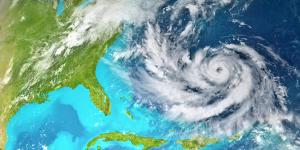Tornado vs. Hurricane Differences Explained


Both tornadoes and hurricanes are extreme weather events defined by their destructive ability and association with thunderstorms. One of the key differences between tornadoes and other thunderstorms are their size, duration and level of destructiveness. Distinctions are also made between their formation since they are created during different atmospheric conditions. With this in mind, we can say that a tornado is a violently rotating column of air that extends from a thunderstorm to the ground, causing concentrated and severe damage in specific areas. In contrast, a hurricane is a large-scale tropical storm that forms over warm oceans and is characterized by strong winds, heavy rain and storm surge.
At thedailyECO, we discover more as we explain the tornado vs. hurricane differences. We provide definitions of each, show how both are formed and make a comparison between them. We also determine whether a tornado or hurricane is more destructive.
What is a hurricane and how is it formed?
A hurricane is a type of tropical storm or cyclone that forms in the ocean. It is characterized by extremely strong winds and heavy rain. Hurricanes develop mainly in the tropical and subtropical regions of the planet. This is where ocean waters are warm enough to provide the energy necessary for their formation. The formation of a hurricane is as follows:
- A hurricane begins with an area of low pressure over the ocean, known as a tropical disturbance. For this disturbance to become a hurricane, several conditions must be met. The ocean water temperature must be at least 26.5 degrees Celsius (78 ºF) as this provides the heat and humidity needed for air to rise and form clouds.
- As warm, moist air rises, it cools and water vapor condenses into raindrops. They release latent heat as they form. This extra heat further warms the surrounding air, causing it to rise higher and form more storm clouds. This process creates a positive feedback loop. Warm, moist air continues to rise and release more heat, which in turn causes the storm system to grow and intensify.
- The Earth's rotation also plays a crucial role in the formation of hurricanes. The Coriolis effect is caused by the Earth's rotation, leading moving air to deflect and storms to begin to pivot. This rotation means a hurricane is a type of cyclone. In the Northern Hemisphere, hurricanes rotate counterclockwise, while in the Southern Hemisphere they rotate clockwise. Learn more about what is the cause of the Coriolis effect in our related guide.
- If conditions remain favorable, the tropical disturbance can organize over time into a stronger weather system. This is known as a tropical depression which then forms into a tropical storm.
- When sustained winds reach 74 mph (119 km/h) or higher, the system is officially classified as a hurricane.
If you want to learn more about the impact of hurricanes, take a look at our article which reveals the most destructive hurricanes in history.

What is a tornado and how is it formed?
A tornado is a violently rotating column of air that extends from a thunderstorm to the ground. Tornadoes can cause significant damage due to their extremely strong winds and their ability to lift and launch debris at high speeds. Although smaller in scale than hurricanes, tornadoes can be equally devastating in localized areas. The formation of a tornado is as follows:
- A tornado begins with the presence of a severe storm, usually a supercell. This is a special type of storm characterized by a mesocyclone, a region of rotating winds within the storm cloud. For a tornado to form, several specific atmospheric conditions must occur.
- There must be warm, moist air near the ground which can be lifted by cooler, drier air in the upper layers of the atmosphere. This contrast between air masses creates atmospheric instability, which favors the formation of intense thunderstorms. Learn more about the composition of the Earth's lowest level of atmosphere with our article on what is the troposphere?
- The next crucial factor is the presence of wind shear. This is a change in wind speed and direction at a great height. Wind shear can cause the air to begin to rotate horizontally.
- When a strong updraft within the storm interacts with this rotating air, it can tilt the horizontal rotation toward a vertical position, creating a mesocyclone.
- If the mesocyclone intensifies and narrows due to conservation of angular momentum, the rotation accelerates and a cloud funnel may form which descends from the cloud base. If this funnel hits the ground, it becomes a tornado.
Tornadoes are classified according to the Enhanced Fujita (EF) Scale, which ranges from EF0 to EF5. This scale is based on the damage caused and estimated wind speed. EF0 tornadoes are the weakest, with winds that can reach speeds of 65-85 mph (105-137 km/h). EF5 tornadoes are extremely violent, with winds that can reach speeds greater than 200 mph (322 km/h).
We now know that tornadoes occur over terrestrial areas. If you want to learn about mesocyclones over water, take a look at our article on the difference between a tornado and a water spout.

Tornado vs. hurricane differences
We now have separate information on how tornadoes and hurricanes are formed. We make a comparison between a tornado vs. a hurricane by explaining their differences below:
- Hurricanes are much larger than tornadoes and cover much more area. They are a more complex weather system which can cause tornadoes to occur within them, although not always.
- There are structural differences between tornadoes vs. hurricanes. Hurricanes have an organized structure with a central eye, an eyewall that contains the strongest winds and spiral rain bands extending from the center. These systems can last several days or weeks, traveling great distances over the ocean and affecting large areas when they make landfall.
- In comparison, tornadoes are smaller in scale and form over land. Tornado formation requires atmospheric instability, high wind shear and a strong updraft within the storm. Unlike hurricanes, tornadoes have no large-scale organized structure and are rather narrow columns of intensely rotating air. Tornadoes are usually short-lived, often lasting only a few minutes, although some may persist longer.
- Another key difference is the size and extent of their impact. Hurricanes can be hundreds of miles in diameter and affect vast areas with winds, torrential rains and storm surges. By comparison, tornadoes are much smaller, typically a few hundred meters in diameter. The damage tornadoes cause is concentrated in a narrow strip. The individual winds of tornadoes is greater, but they can also occur within a hurricane.
- Hurricanes are easier to monitor because of their size and the time they take to develop and move. Authorities can issue warnings days in advance, allowing for evacuation and other preparedness measures. In contrast, tornadoes can form quickly and with little warning, making warnings more challenging and often with a shorter window for action.
Learn more about wind power with our article exploring when is a wind considered a strong wind?

Is a tornado more dangerous than a hurricane?
Determining whether a tornado or hurricane is more dangerous depends on several factors, including the specific context and circumstances of each weather phenomenon. Both can be extremely dangerous and cause significant damage, but their dangers manifest in different ways.
Comparing both phenomena, hurricanes tend to cause more widespread damage and long-term effects due to their size and duration. Evacuations and preparations can be better planned due to the ability to predict and follow the path of hurricanes several days in advance. They can also contain tornadoes within them, meaning the individual power of each single tornado contributes to the overall destructiveness of a hurricane.
Tornadoes are more unpredictable. Although they affect smaller areas, they can be more deadly in those areas due to the speed and intensity of their impact. The speed with which they develop and the intensity of their winds mean that a lack of preparation can have catastrophic consequences in just a short period.
We have discovered the differences between hurricanes vs. tornadoes, but we can see that they are linked to various other weather phenomena. Learn more about the destructive potential of nature with our articles on the how tsunamis form and what are the consequences of floods.
If you want to read similar articles to Tornado vs. Hurricane Differences Explained, we recommend you visit our Meteorological phenomena category.








